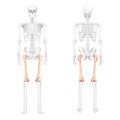Find results that contain all of your keywords. Content filter is on.
Search will return best illustrations, stock vectors and clipart.
Choose orientation:
Make it so!
You have chosen to exclude "" from your results.
Choose orientation:
Explore cartoons & images using related keywords:
anatomy
ankle
appendicular
body
bone
bones
cuboid
cuboidbone female femur fibula foot gridle heel heelbone hinge hip human joint joints knee leg legs limbs lowerlegbones lowerlimbs male matatarsals pelvic phalanges skeletal skeleton sockethip sockethipjoint synovial synovialhinge synovialhingejoint talus tarsals tarsus tarsusbone thighbone tibia toe toesSkeleton: Hip, Femur, Tibia, Fibula, Ankle And Foot Bones Royalty-Free Stock Photography
Designed by
Title
Skeleton: Hip, Femur, Tibia, Fibula, Ankle and Foot bones #43014617
Description

















